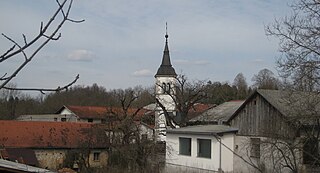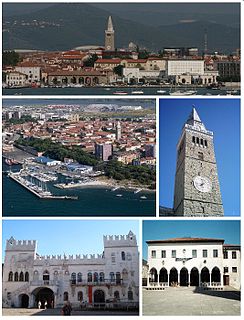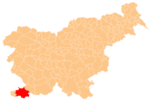
Pivka is a small town in Slovenia in the Pivka Basin in the Karst region. It is the seat of the Municipality of Pivka. It belongs to the traditional region of Inner Carniola.

Sveti Anton is a settlement in the City Municipality of Koper in the Littoral region of Slovenia. It includes the hamlets of Boškarji, Bužarji, Cerej, Dolani, Dvori, Farančan, Fikoni, Gregoriči, Kavaliči, Kortina, Pečki, Škofarji, Sušteti, Tomažiči, Turki, and Vrtine.

Šmihel is a dispersed settlement in the Municipality of Nova Gorica in western Slovenia. It is located in the lower Vipava Valley.

Zadnja Vas is a small village in the Municipality of Radovljica in the Upper Carniola region of Slovenia.

Brezje pri Tržiču is a settlement in the Municipality of Tržič in the Upper Carniola region of Slovenia. It is located near the road from Tržič to Begunje. In 2002 it had a population of 361.

Vrh pri Dolskem is a dispersed settlement in the hills northeast of Dolsko in the Municipality of Dol pri Ljubljani in the Upper Carniola region of Slovenia.

Vipavski Križ is a settlement on a small hill in the Vipava Valley in the Municipality of Ajdovščina in the Littoral region of Slovenia. It is one of the historically most interesting places in the area. There is evidence of habitation on the hill in the pre-Roman period. The settlement was first mentioned in written documents dating to the 13th century. The houses in the village are clustered inside a defence wall around a castle from the late 15th century. It was built to protect the residents against Ottoman raids. In 1532 Vipavski Križ was declared a town. In 1636 a Capuchin monastery with a rich library was founded in the town and it is now open to visitors.

Podnanos is a village in the upper Vipava Valley in the Municipality of Vipava in the Littoral region of Slovenia. It lies below Mount Nanos, from which it gets its current name.

Slovenska Vas is a small village northeast of Pivka in the Inner Carniola region of Slovenia. Traditional agricultural activity of the village is linked to growing potatoes and oats and raising cattle, as well as some orchard and beekeeping activity.

Šmihel is a village south of Pivka in the Inner Carniola region of Slovenia.

Sveti Duh is a small village north of Nova Vas in the Municipality of Bloke in the Inner Carniola region of Slovenia.

Šentanel is a settlement in the hills northwest of Prevalje in the Carinthia region in northern Slovenia.

Kamence is a settlement in the Municipality of Rogaška Slatina in eastern Slovenia, close to the border with Croatia. The area traditionally belonged to the region of Styria. It is now included in the Savinja Statistical Region.

Vidovica is a settlement in the Municipality of Podčetrtek in eastern Slovenia, close to the border with Croatia. The area was traditionally part of the Styria region. It is now included in the Savinja Statistical Region.

Vrhe is a settlement in the Municipality of Trbovlje in central Slovenia. It lies in the hills northwest of the town of Trbovlje and part of the settlement lies in the neighbouring Municipality of Zagorje ob Savi. Traditionally the area was part of the Styria region. It is now included with the rest of the municipality in the Central Sava Statistical Region.

Gore is a settlement in the Municipality of Hrastnik in central Slovenia. Traditionally the area was part of the Styria region. It is now included with the rest of the municipality in the Central Sava Statistical Region.

Turje is a settlement in the hills southeast of Dol in the Municipality of Hrastnik in central Slovenia. Traditionally the area was part of the Styria region. It is now included with the rest of the municipality in the Central Sava Statistical Region.

Jelovice is a settlement in the western Haloze Hills in the Municipality of Majšperk in northeastern Slovenia. The area is part of the traditional region of Styria. It is now included with the rest of the municipality in the Drava Statistical Region.

Brnica is a small settlement in hills on the right bank of the Savinja River in the Municipality of Žalec in east-central Slovenia. The area is part of the traditional region of Styria. The municipality is now included in the Savinja Statistical Region.

Podgaj is a small settlement south of Ponikva in the Municipality of Šentjur in eastern Slovenia. Traditionally the area is part of Styria. The municipality is now included in the Savinja Statistical Region.















